
Wellness Cat Food Ingredients
According to our research, Wellness manufactures 104 cat food recipes using 165 unique ingredients. To evaluate the quality of ingredients used by Wellness, we've studied all 165 ingredients. In this article, we'll share our findings on Wellness ingredients.
| Cat Food Recipes | 104 |
| Unique Ingredients | 165 |
| Artificial Colors | 0 |
| Animal By-Products | 0 |
| Anonymous Meats | 0 |
| Controversial | 6 |
| Harmful | 2 |
First 5 Ingredients
Cat food ingredients in the United States are listed in descending order of pre-cooked weight. The first 5 ingredients typically constitute a significant portion of the recipe.
For Wellness, these are the most common ingredients found within the first 5 cat food ingredients.
- chicken
- chicken broth
- water sufficient for processing
- potato starch
- dried egg whites
As you can see, the most common first ingredient in Wellness is chicken. The most common 2nd ingredient is chicken broth, followed by water sufficient for processing, potato starch, and dried egg whites.
Artificial Food Coloring Dyes
Wellness does not use any artificial food coloring dyes. According to our records, none of the 104 Wellness cat foods contain artificial food dyes.
Artificial food coloring dyes are unnecessary and potentially harmful ingredients. In general, we not not recommend feeding any pet foods that contain artificial dyes.
In 2010, the CSPI raised serious concerns regarding the safety of many artificial dyes. Most of the studies referenced by the CSPI involved prolonged or excessive consumption. Since most cats consume the same foods throughout their lives, concerns raised by the CSPI are alarming to say the least.
To read more about Artificial Food Dyes, click here.
Animal By-Products
According to our records, Wellness does not contain any animal by-products.
Animal by-products are basically the leftover parts of the the carcass after its been processed for meat. AAFCO defines by-products as the non-rendered, clean parts, other than meat, derived from slaughtered mammals.
Although by-products are still fairly nutritious ingredients, consumers have equated them with slaughterhouse waste. Therefore, most premium brands, including Wellness have decided to remove by-products and instead use named organ meats (beef liver, chicken gizzards).
For further reading on the controversy over animal by-products, click here.
Anonymous Meat Ingredients
Anonymous meats are inexpensive low-quality ingredients that can come from practically any animal. These type of ingredients are often used to produce very inexpensive cat foods.
In general, we prefer ingredients which specify the animal source used to derive the ingredient. For example, ingredients such as duck fat are much better than animal fat or poultry fat.
In our analysis, we've looked through all 165 Wellness ingredients. According to our data, Wellness does not contain any anonymous animal-based ingredients.
Cereal Grains
Certain Wellness cat food recipes contain one or more grains. The specific ingredients are listed below.
For cats, we typically recommend choosing a grain-free recipe. Cats are obligate carnivores and therefore grains are not species appropriate.
The kibble production requires a binding agent. Grains are commonly used for this purpose in cat food. When purchasing grain-free cat food, grains are often replaced with another starchy source. This is also not ideal.
To avoid grains and other starchy additions, consider feeding wet or frozen recipes.
Barley is a nutritious carbohydrate source, naturally rich in dietary fiber and various minerals. Unlike pearled barley, regular barley contains the entire grain.
The following recipes contain barley:
- Wellness Complete Health Chicken, Chicken Meal & Rice Recipe With Wholesome Grains For Cats
- Wellness Complete Health Deboned Chicken & Chicken Meal Recipe For Senior Cats
- Wellness Complete Health Chicken & Chicken Meal Recipe With Wholesome Grains For Indoor Cats
- Wellness Complete Health Salmon & Salmon Meal Recipe With Wholesome Grains For Cats
- Wellness Complete Health Healthy Weight Deboned Chicken, Chicken Meal & Turkey Meal Recipe
- Wellness Core Digestive Health Chicken & Rice Recipe With Wholesome Grains For Cats
- Wellness Core Digestive Health Salmon & Rice Recipe With Wholesome Grains For Cats
Brewer's rice is the small fragments of rice kernel that are separated from the larger kernels of milled rice. The fragments do not contain the same nutrition profile of the whole kernel and therefore brewer's rice is a lower quality grain. Brewer's rice is typically regarded as an inexpensive and low quality filler.
The following recipes contain brewers rice:
Oats are an excellent carbohydrate source with considerable nutrients in addition to dietary fiber. More specifically, oats are rich in B vitamins and various minerals including manganese.
The following recipes contain oats:
- Wellness Complete Health Chicken, Chicken Meal & Rice Recipe With Wholesome Grains For Cats
- Wellness Complete Health Deboned Chicken & Chicken Meal Recipe For Senior Cats
- Wellness Complete Health Chicken & Chicken Meal Recipe With Wholesome Grains For Indoor Cats
- Wellness Core Digestive Health Chicken & Rice Recipe With Wholesome Grains For Cats
- Wellness Core Digestive Health Salmon & Rice Recipe With Wholesome Grains For Cats
Oatmeal is simply coarsely ground oats and therefore contains the entire oat grain. As with regular oats, oatmeal is rich in dietary fiber, B vitamins, and various minerals.
The following recipes contain oatmeal:
Rice is a gluten-free carbohydrate source. As long as the bran and germ of the grain are intact, rice can provide a notable amount of fiber and nutrition. However, because the type of rice ("brown" or "white") is not specified, we cannot make this determination.
The following recipes contain rice:
- Wellness Complete Health Chicken, Chicken Meal & Rice Recipe With Wholesome Grains For Cats
- Wellness Complete Health Deboned Chicken & Chicken Meal Recipe For Senior Cats
- Wellness Complete Health Chicken & Chicken Meal Recipe With Wholesome Grains For Indoor Cats
- Wellness Complete Health Salmon & Salmon Meal Recipe With Wholesome Grains For Cats
- Wellness Complete Health Healthy Weight Deboned Chicken, Chicken Meal & Turkey Meal Recipe
- Wellness Core Digestive Health Chicken & Rice Recipe With Wholesome Grains For Cats
- Wellness Core Digestive Health Salmon & Rice Recipe With Wholesome Grains For Cats
Ground brown rice is naturally rich in fiber and various minerals including manganese, phosphorus, and magnesium. Relative to other grains, ground brown rice is easy to digest.
The following recipes contain ground brown rice:
Controversial Ingredients
In most cases, ingredients which are given the controversial classification can be substituted with higher-quality alternatives. You should evaluate each controversial ingredient independently to see if there is truly a valid cause for concern.
Keep in mind, certain sacrifices often must be made to produce cat foods at a reasonable price. In general, the more expensive the product, the fewer controversial ingredients you'll find.
In our analysis, we've identified 6 controversial ingredients inside Wellness products. These controversial ingredients are listed below. Click on each ingredient for more information.
Dried tomato pomace is a by-product of tomato manufacturing. It's considered a controversial ingredient because many people believe it is an inexpensive low quality filler. However, tomato pomace provides a notable amount of dietary fiber, B vitamins, Lycopene, and vitamin A. Although it is a very inexpensive ingredient, it is not nutritionally empty.
The following recipes contain dried tomato pomace:
Brewer's rice is the small fragments of rice kernel that are separated from the larger kernels of milled rice. The fragments do not contain the same nutrition profile of the whole kernel and therefore brewer's rice is a lower quality grain. Brewer's rice is typically regarded as an inexpensive and low quality filler.
The following recipes contain brewers rice:
Pea protein is produced by removing the starchy parts of peas. Pea protein is considered controversial because it provides a substantial plant based protein boost. This boost is undesirable because plant based protein is typically lower in biological value when compared to meat based proteins.
The following recipes contain pea protein:
Canola oil is a plant-derived oil from the seeds of canola plants. Although fat is an essential component of any diet, canola oil is controversial in pet food. Proponents claim that canola oil provides a better fat profile in comparison to other plant based oils. However, opponents claim that canola oil is typically produced with genetically modified rapeseed and that rapeseed oil has multiple adverse health affects.
The following recipes contain canola oil (preserved with mixed tocopherols):
Canola oil is a plant-derived oil from the seeds of canola plants. Although fat is an essential component of any diet, canola oil is controversial in pet food. Proponents claim that canola oil provides a better fat profile in comparison to other plant based oils. However, opponents claim that canola oil is typically produced with genetically modified rapeseed and that rapeseed oil has multiple adverse health affects.
The following recipes contain canola oil:
- Wellness Core Grain Free Turkey, Turkey Meal & Duck Formula For Adult Cats
- Wellness Core Classic Pate Whitefish, Salmon & Herring Recipe
- Wellness Minced Salmon Dinner
- Wellness Core Hearty Cuts In Gravy Shredded Chicken & Tuna Recipe
- Wellness Core Hearty Cuts In Gravy Shredded Chicken & Turkey Recipe
- Wellness Core Hearty Cuts In Gravy Shredded Whitefish & Salmon Recipe
- Wellness Complete Health Grain Free Salmon & Herring Meal Recipe For Indoor Cats
Tomato pomace is a by-product of tomato manufacturing. It's considered a controversial ingredient because many people believe it is an inexpensive low quality filler. However, tomato pomace provides a notable amount of dietary fiber, B vitamins, Lycopene, and vitamin A. Although it is a very inexpensive ingredient, it is not nutritionally empty.
The following recipes contain tomato pomace:
- Wellness Complete Health Chicken, Chicken Meal & Rice Recipe With Wholesome Grains For Cats
- Wellness Complete Health Deboned Chicken & Chicken Meal Recipe For Senior Cats
- Wellness Complete Health Chicken & Chicken Meal Recipe With Wholesome Grains For Indoor Cats
- Wellness Core Grain Free Deboned Turkey, Turkey Meal & Deboned Chicken For Kittens
- Wellness Core Grain Free Original Formula - Deboned Turkey, Turkey Meal & Chicken Meal Recipe
- Wellness Core Grain Free Turkey, Turkey Meal & Duck Formula For Adult Cats
- Wellness Core Grain Free Deboned Chicken, Turkey & Chicken Meals Recipe For Indoor Cats
- Wellness Complete Health Grain Free Deboned Chicken & Chicken Meal Recipe For Adult Cats
- Wellness Complete Health Grain Free Deboned Chicken & Chicken Meal Recipe For Kittens
- Wellness Complete Health Salmon & Salmon Meal Recipe With Wholesome Grains For Cats
- Wellness Complete Health Grain Free Salmon & Herring Meal Recipe For Indoor Cats
- Wellness Complete Health Healthy Weight Deboned Chicken, Chicken Meal & Turkey Meal Recipe
- Wellness Complete Health Grain Free Deboned Chicken & Chicken Meal Recipe For Indoor Cats
- Wellness Complete Health Grain Free Deboned Chicken & Turkey Meal Recipe For Healthy Weight Indoor Cats
- Wellness Core RawRev Indoor - Deboned Chicken, Turkey Meal & Chicken Meal Recipe
- Wellness Core RawRev Original - Deboned Turkey, Turkey Meal & Chicken Meal Recipe
- Wellness Core Grain Free Salmon & Herring Meal Recipe For Indoor Cats
- Wellness Complete Health Grain Free Deboned Chicken & Chicken Meal Recipe For Senior Cats
- Wellness Core Digestive Health Chicken & Rice Recipe With Wholesome Grains For Cats
- Wellness Core Digestive Health Salmon & Rice Recipe With Wholesome Grains For Cats
Potentially Harmful Ingredients
Harmful ingredients are those which have been linked to adverse health effects. In general, we do not recommend feeding any product which contains any harmful ingredients.
There are certain situations where these ingredients may be necessary. We always recommend contacting Wellness for further clarification regarding any harmful or controversial ingredient.
We have identified 2 harmful ingredients used in certain Wellness recipes. To learn more, click on the ingredient's name.
Menadione sodium bisulfite is a synthetic version of vitamin K that has been linked to many health concerns. Research has suggested possible toxic reactions in liver cells and red blood cells among other serious problems. In fact, one large chemical supplier warns, "The substance is toxic to kidneys, lungs, liver, mucous membranes. Repeated or prolonged exposure to the substance can produce target organs damage."
The following recipes contain menadione sodium bisulfite:
Menadione sodium bisulfite complex is a synthetic version of vitamin K that has been linked to many health concerns. Research has suggested possible toxic reactions in liver cells and red blood cells among other serious problems. In fact, one large chemical supplier warns, "The substance is toxic to kidneys, lungs, liver, mucous membranes. Repeated or prolonged exposure to the substance can produce target organs damage."
The following recipes contain menadione sodium bisulfite complex:
- Wellness Signature Selects Flaked Skipjack Tuna & Wild Salmon Entree In Broth
- Wellness Signature Selects Flaked Skipjack Tuna & Shrimp Entree In Broth
- Wellness Complete Health Salmon & Salmon Meal Recipe With Wholesome Grains For Cats
- Wellness Complete Health Grain Free Salmon & Herring Meal Recipe For Indoor Cats
- Wellness Core Tiny Tasters Tuna & Salmon Recipe Smooth Pate
- Wellness Core Tiny Tasters Tuna Recipe Smooth Pate
- Wellness Core Digestive Health Salmon & Rice Recipe With Wholesome Grains For Cats
Wellness Cat Food Ingredient Lists
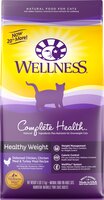
Wellness
Complete Health
Healthy Weight Deboned Chicken, Chicken Meal & Turkey Meal Recipe
Wellness
Complete Health Healthy Weight Deboned Chicken, Chicken Meal & Turkey Meal Recipe
First Five Ingredients
chickenchicken meal
rice
barley
ground brown rice
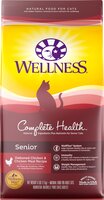
Wellness
Complete Health
Deboned Chicken & Chicken Meal Recipe For Senior Cats
Wellness
Complete Health Deboned Chicken & Chicken Meal Recipe For Senior Cats
First Five Ingredients
chickenchicken meal
rice
barley
herring meal
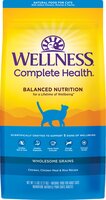
Wellness
Complete Health
Chicken, Chicken Meal & Rice Recipe With Wholesome Grains For Cats
Wellness
Complete Health Chicken, Chicken Meal & Rice Recipe With Wholesome Grains For Cats
First Five Ingredients
chickenchicken meal
rice
barley
oats
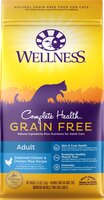
Wellness
Complete Health Grain Free
Deboned Chicken & Chicken Meal Recipe For Adult Cats
Wellness
Complete Health Grain Free Deboned Chicken & Chicken Meal Recipe For Adult Cats
First Five Ingredients
chickenchicken meal
pea
chickpea
chicken fat
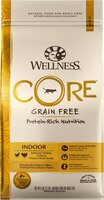
Wellness
Core Grain Free
Deboned Chicken, Turkey & Chicken Meals Recipe For Indoor Cats
Wellness
Core Grain Free Deboned Chicken, Turkey & Chicken Meals Recipe For Indoor Cats
First Five Ingredients
chickenturkey meal
chicken meal
pea
potato
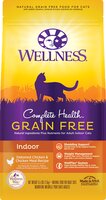
Wellness
Complete Health Grain Free
Deboned Chicken & Chicken Meal Recipe For Indoor Cats
Wellness
Complete Health Grain Free Deboned Chicken & Chicken Meal Recipe For Indoor Cats
First Five Ingredients
chickenchicken meal
dried ground potato
pea
turkey meal
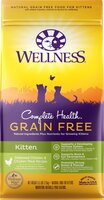
Wellness
Complete Health Grain Free
Deboned Chicken & Chicken Meal Recipe For Kittens
Wellness
Complete Health Grain Free Deboned Chicken & Chicken Meal Recipe For Kittens
First Five Ingredients
chickenchicken meal
pea
chickpea
chicken fat
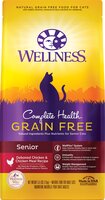
Wellness
Complete Health Grain Free
Deboned Chicken & Chicken Meal Recipe For Senior Cats
Wellness
Complete Health Grain Free Deboned Chicken & Chicken Meal Recipe For Senior Cats
First Five Ingredients
chickenchicken meal
pea
herring meal
potato
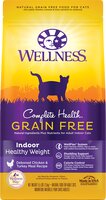
Wellness
Complete Health Grain Free
Deboned Chicken & Turkey Meal Recipe For Healthy Weight Indoor Cats
Wellness
Complete Health Grain Free Deboned Chicken & Turkey Meal Recipe For Healthy Weight Indoor Cats
First Five Ingredients
chickenchicken meal
turkey meal
pea
dried ground potato
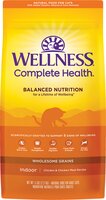
Wellness
Complete Health
Chicken & Chicken Meal Recipe With Wholesome Grains For Indoor Cats
Wellness
Complete Health Chicken & Chicken Meal Recipe With Wholesome Grains For Indoor Cats
First Five Ingredients
chickenchicken meal
rice
herring meal
barley
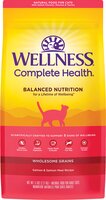
Wellness
Complete Health
Salmon & Salmon Meal Recipe With Wholesome Grains For Cats
Wellness
Complete Health Salmon & Salmon Meal Recipe With Wholesome Grains For Cats
First Five Ingredients
salmonsalmon meal
herring meal
menhaden meal
rice
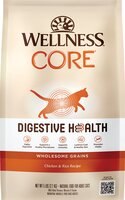
Wellness
Core Digestive Health
Chicken & Rice Recipe With Wholesome Grains For Cats
Wellness
Core Digestive Health Chicken & Rice Recipe With Wholesome Grains For Cats
First Five Ingredients
chickenchicken meal
rice
barley
oats
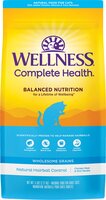
Wellness
Complete Health
Chicken Meal & Rice Recipe With Wholesome Grains (Natural Hairball Control) For Cats
Wellness
Complete Health Chicken Meal & Rice Recipe With Wholesome Grains (Natural Hairball Control) For Cats
First Five Ingredients
chicken mealbrewers rice
chicken
pea fiber
turkey meal
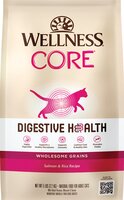
Wellness
Core Digestive Health
Salmon & Rice Recipe With Wholesome Grains For Cats
Wellness
Core Digestive Health Salmon & Rice Recipe With Wholesome Grains For Cats
First Five Ingredients
salmonsalmon meal
herring meal
menhaden meal
barley
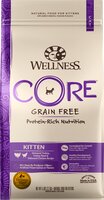
Wellness
Core Grain Free
Deboned Turkey, Turkey Meal & Deboned Chicken For Kittens
Wellness
Core Grain Free Deboned Turkey, Turkey Meal & Deboned Chicken For Kittens
First Five Ingredients
turkeyturkey meal
chicken
chicken meal
pea
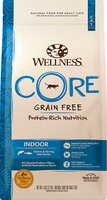
Wellness
Core Grain Free
Salmon & Herring Meal Recipe For Indoor Cats
Wellness
Core Grain Free Salmon & Herring Meal Recipe For Indoor Cats
First Five Ingredients
salmonmenhaden meal
pea
herring meal
dried ground potato
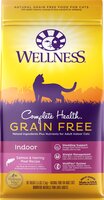
Wellness
Complete Health Grain Free
Salmon & Herring Meal Recipe For Indoor Cats
Wellness
Complete Health Grain Free Salmon & Herring Meal Recipe For Indoor Cats
First Five Ingredients
salmonpea
menhaden meal
potato
herring meal
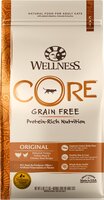
Wellness
Core Grain Free
Original Formula - Deboned Turkey, Turkey Meal & Chicken Meal Recipe
Wellness
Core Grain Free Original Formula - Deboned Turkey, Turkey Meal & Chicken Meal Recipe
First Five Ingredients
turkeychicken
turkey meal
chicken meal
pea
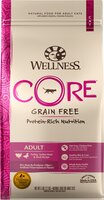
Wellness
Core Grain Free
Turkey, Turkey Meal & Duck Formula For Adult Cats
Wellness
Core Grain Free Turkey, Turkey Meal & Duck Formula For Adult Cats
First Five Ingredients
turkeyturkey meal
pea
pea protein
pork meal
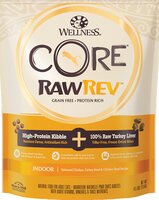
Wellness
Core RawRev
Indoor - Deboned Chicken, Turkey Meal & Chicken Meal Recipe
Wellness
Core RawRev Indoor - Deboned Chicken, Turkey Meal & Chicken Meal Recipe
First Five Ingredients
chickenturkey meal
chicken meal
pea
potato
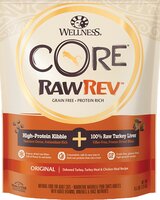
Wellness
Core RawRev
Original - Deboned Turkey, Turkey Meal & Chicken Meal Recipe
Wellness
Core RawRev Original - Deboned Turkey, Turkey Meal & Chicken Meal Recipe
First Five Ingredients
turkeychicken
turkey meal
chicken meal
pea
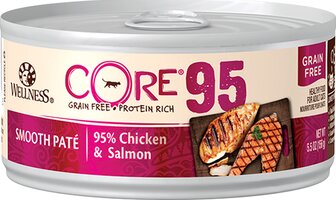
Wellness
Core
95% Chicken & Salmon Smooth Pate
Wellness
Core 95% Chicken & Salmon Smooth Pate
First Five Ingredients
chickensalmon
water sufficient for processing
cassia gum
xanthan gum
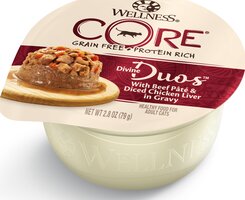
Wellness
Core Divine Duos
With Beef Pate & Diced Chicken Liver In Gravy
Wellness
Core Divine Duos With Beef Pate & Diced Chicken Liver In Gravy
First Five Ingredients
chicken brothwater sufficient for processing
chicken
potato starch
beef
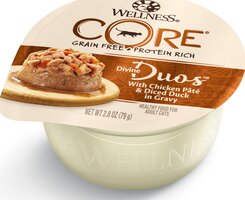
Wellness
Core Divine Duos
With Chicken Pate & Diced Duck In Gravy
Wellness
Core Divine Duos With Chicken Pate & Diced Duck In Gravy
First Five Ingredients
chicken brothwater sufficient for processing
chicken
potato starch
duck
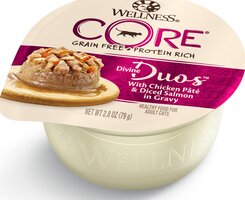
Wellness
Core Divine Duos
With Chicken Pate & Diced Salmon In Gravy
Wellness
Core Divine Duos With Chicken Pate & Diced Salmon In Gravy
First Five Ingredients
chicken brothwater sufficient for processing
chicken
potato starch
salmon
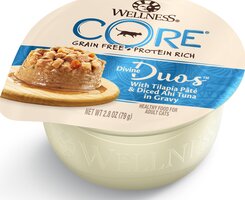
Wellness
Core Divine Duos
With Tilapia Pate & Diced Ahi Tuna In Gravy
Wellness
Core Divine Duos With Tilapia Pate & Diced Ahi Tuna In Gravy
First Five Ingredients
chicken brothwater sufficient for processing
chicken
potato starch
tilapia
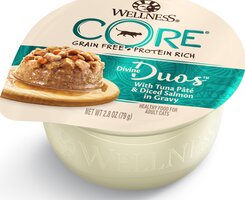
Wellness
Core Divine Duos
With Tuna Pate & Diced Salmon In Gravy
Wellness
Core Divine Duos With Tuna Pate & Diced Salmon In Gravy
First Five Ingredients
chicken brothwater sufficient for processing
chicken
potato starch
tuna
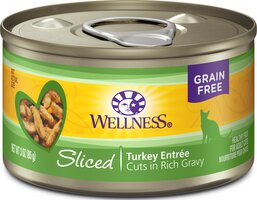
Wellness
Sliced
Turkey Entree
Wellness
Sliced Turkey Entree
First Five Ingredients
turkeyturkey broth
water sufficient for processing
dried ground pea
dried egg whites
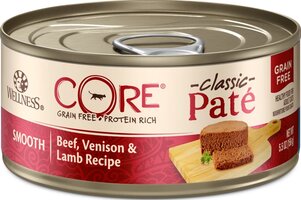
Wellness
Core Classic Pate
Beef, Venison & Lamb Recipe
Wellness
Core Classic Pate Beef, Venison & Lamb Recipe
First Five Ingredients
beefbeef broth
beef liver
lamb liver
venison
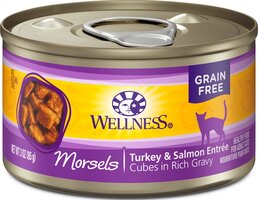
Wellness
Morsels
Turkey & Salmon Entree
Wellness
Morsels Turkey & Salmon Entree
First Five Ingredients
turkeyturkey broth
water sufficient for processing
salmon
dried ground pea
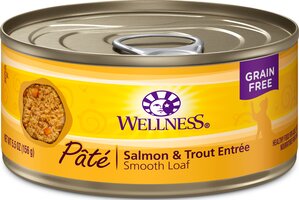
Wellness
Pate
Salmon & Trout Entree
Wellness
Pate Salmon & Trout Entree
First Five Ingredients
chickensalmon
salmon broth
trout
carrot
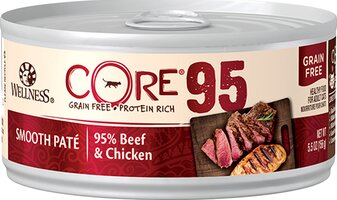
Wellness
Core
95% Beef & Chicken Smooth Pate
Wellness
Core 95% Beef & Chicken Smooth Pate
First Five Ingredients
beefchicken
water sufficient for processing
cassia gum
xanthan gum
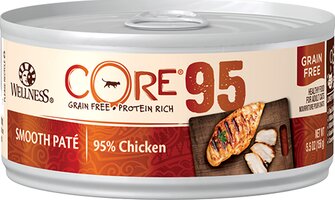
Wellness
Core
95% Chicken Smooth Pate
Wellness
Core 95% Chicken Smooth Pate
First Five Ingredients
chickenwater sufficient for processing
cassia gum
xanthan gum
ground flaxseed
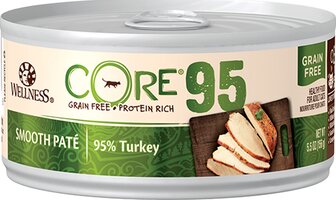
Wellness
Core
95% Turkey Smooth Pate
Wellness
Core 95% Turkey Smooth Pate
First Five Ingredients
turkeywater sufficient for processing
cassia gum
xanthan gum
ground flaxseed
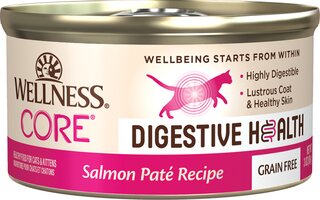
Wellness
Core Digestive Health
Salmon Paté Recipe For Cats
Wellness
Core Digestive Health Salmon Paté Recipe For Cats
First Five Ingredients
salmon brothsalmon
chicken
chicken liver
whitefish
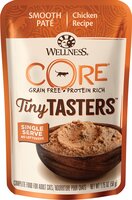
Wellness
Core Tiny Tasters
Chicken Recipe Smooth Pate
Wellness
Core Tiny Tasters Chicken Recipe Smooth Pate
First Five Ingredients
chickenchicken broth
water sufficient for processing
natural flavor
tapioca starch
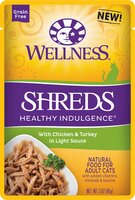
Wellness
Healthy Indulgence Shreds
With Chicken & Turkey In Light Sauce
Wellness
Healthy Indulgence Shreds With Chicken & Turkey In Light Sauce
First Five Ingredients
chicken brothwater sufficient for processing
chicken
potato starch
turkey
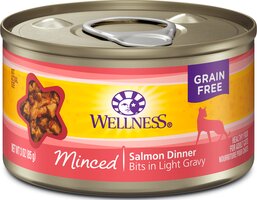
Wellness
Minced
Salmon Dinner
Wellness
Minced Salmon Dinner
First Five Ingredients
salmonfish broth
water sufficient for processing
dried egg whites
dried ground pea
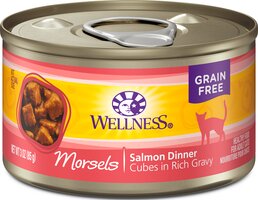
Wellness
Morsels
Salmon Dinner
Wellness
Morsels Salmon Dinner
First Five Ingredients
salmonfish broth
water sufficient for processing
dried egg whites
dried ground pea
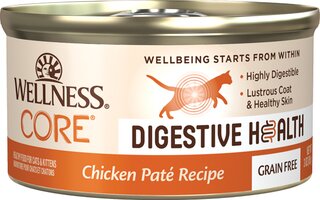
Wellness
Core Digestive Health
Chicken Paté Recipe For Cats
Wellness
Core Digestive Health Chicken Paté Recipe For Cats
First Five Ingredients
chickenchicken liver
chicken broth
turkey
ground flaxseed
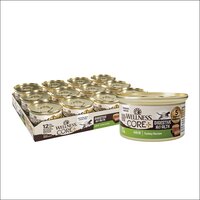
Wellness
Core Digestive Health
Turkey Paté Recipe For Cats
Wellness
Core Digestive Health Turkey Paté Recipe For Cats
First Five Ingredients
turkeychicken liver
turkey broth
chicken
ground flaxseed
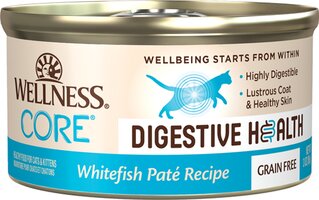
Wellness
Core Digestive Health
Whitefish Paté Recipe For Cats
Wellness
Core Digestive Health Whitefish Paté Recipe For Cats
First Five Ingredients
whitefishchicken
salmon broth
chicken liver
salmon
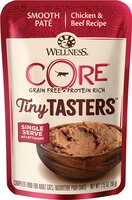
Wellness
Core Tiny Tasters
Chicken & Beef Recipe Smooth Pate
Wellness
Core Tiny Tasters Chicken & Beef Recipe Smooth Pate
First Five Ingredients
chickenchicken broth
water sufficient for processing
beef
natural flavor
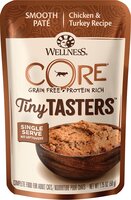
Wellness
Core Tiny Tasters
Chicken & Turkey Recipe Smooth Pate
Wellness
Core Tiny Tasters Chicken & Turkey Recipe Smooth Pate
First Five Ingredients
chickenchicken broth
water sufficient for processing
turkey
natural flavor
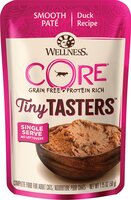
Wellness
Core Tiny Tasters
Duck Recipe Smooth Pate
Wellness
Core Tiny Tasters Duck Recipe Smooth Pate
First Five Ingredients
duckchicken
chicken broth
water sufficient for processing
natural flavor
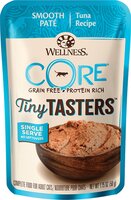
Wellness
Core Tiny Tasters
Tuna Recipe Smooth Pate
Wellness
Core Tiny Tasters Tuna Recipe Smooth Pate
First Five Ingredients
tunachicken
fish broth
water sufficient for processing
sunflower oil
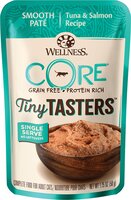
Wellness
Core Tiny Tasters
Tuna & Salmon Recipe Smooth Pate
Wellness
Core Tiny Tasters Tuna & Salmon Recipe Smooth Pate
First Five Ingredients
tunafish broth
water sufficient for processing
salmon
sunflower oil
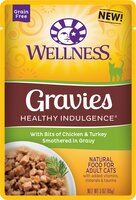
Wellness
Healthy Indulgence Gravies
Chicken & Turkey Smothered In Gravy
Wellness
Healthy Indulgence Gravies Chicken & Turkey Smothered In Gravy
First Five Ingredients
chicken brothwater sufficient for processing
chicken
potato starch
turkey
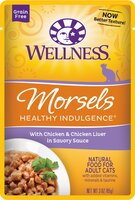
Wellness
Healthy Indulgence Morsels
With Chicken & Chicken Liver In Savory Sauce
Wellness
Healthy Indulgence Morsels With Chicken & Chicken Liver In Savory Sauce
First Five Ingredients
chicken brothwater sufficient for processing
chicken
chicken liver
potato starch
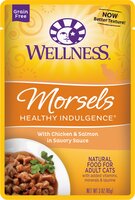
Wellness
Healthy Indulgence Morsels
With Chicken & Salmon In Savory Sauce
Wellness
Healthy Indulgence Morsels With Chicken & Salmon In Savory Sauce
First Five Ingredients
chicken brothwater sufficient for processing
chicken
salmon
potato starch
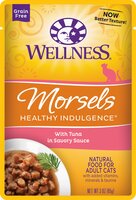
Wellness
Healthy Indulgence Morsels
With Tuna In Savory Sauce
Wellness
Healthy Indulgence Morsels With Tuna In Savory Sauce
First Five Ingredients
chicken brothwater sufficient for processing
chicken
tuna
potato starch

Wellness
Healthy Indulgence Shreds
With Skipjack Tuna & Shrimp In Light Sauce
Wellness
Healthy Indulgence Shreds With Skipjack Tuna & Shrimp In Light Sauce
First Five Ingredients
chicken brothwater sufficient for processing
chicken
potato starch
tuna
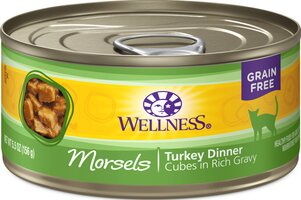
Wellness
Morsels
Turkey Dinner
Wellness
Morsels Turkey Dinner
First Five Ingredients
turkeyturkey broth
water sufficient for processing
dried ground pea
dried egg whites
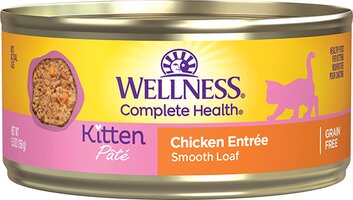
Wellness
Pate
Chicken Entree For Kittens
Wellness
Pate Chicken Entree For Kittens
First Five Ingredients
chickenchicken liver
chicken broth
carrot
natural flavor
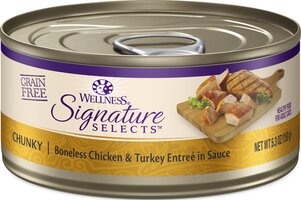
Wellness
Signature Selects
Chunky Boneless Chicken & Turkey Entree In Sauce
Wellness
Signature Selects Chunky Boneless Chicken & Turkey Entree In Sauce
First Five Ingredients
chickenchicken broth
water sufficient for processing
potato starch
egg
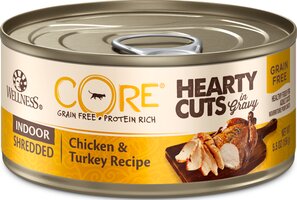
Wellness
Core Hearty Cuts In Gravy
Shredded Chicken & Turkey Recipe For Indoor Cats
Wellness
Core Hearty Cuts In Gravy Shredded Chicken & Turkey Recipe For Indoor Cats
First Five Ingredients
chickenchicken broth
turkey broth
chicken liver
turkey
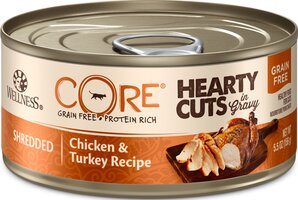
Wellness
Core Hearty Cuts In Gravy
Shredded Chicken & Turkey Recipe
Wellness
Core Hearty Cuts In Gravy Shredded Chicken & Turkey Recipe
First Five Ingredients
chickenchicken broth
turkey broth
chicken liver
turkey
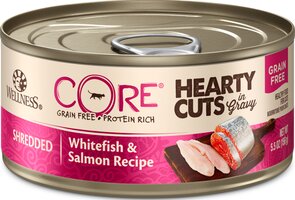
Wellness
Core Hearty Cuts In Gravy
Shredded Whitefish & Salmon Recipe
Wellness
Core Hearty Cuts In Gravy Shredded Whitefish & Salmon Recipe
First Five Ingredients
whitefishsalmon broth
turkey broth
turkey liver
turkey
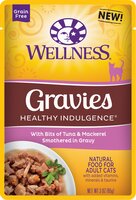
Wellness
Healthy Indulgence Gravies
Tuna & Mackerel Smothered In Gravy
Wellness
Healthy Indulgence Gravies Tuna & Mackerel Smothered In Gravy
First Five Ingredients
chicken brothwater sufficient for processing
chicken
potato starch
tuna
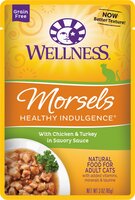
Wellness
Healthy Indulgence Morsels
With Chicken & Turkey In Savory Sauce
Wellness
Healthy Indulgence Morsels With Chicken & Turkey In Savory Sauce
First Five Ingredients
chicken brothwater sufficient for processing
chicken
turkey
potato starch
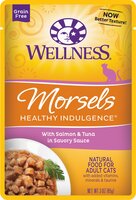
Wellness
Healthy Indulgence Morsels
With Salmon & Tuna In Savory Sauce
Wellness
Healthy Indulgence Morsels With Salmon & Tuna In Savory Sauce
First Five Ingredients
chicken brothwater sufficient for processing
chicken
salmon
tuna
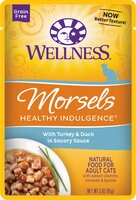
Wellness
Healthy Indulgence Morsels
With Turkey & Duck In Savory Sauce
Wellness
Healthy Indulgence Morsels With Turkey & Duck In Savory Sauce
First Five Ingredients
chicken brothwater sufficient for processing
chicken
turkey
duck
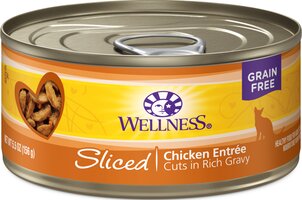
Wellness
Sliced
Chicken Entree
Wellness
Sliced Chicken Entree
First Five Ingredients
chickenchicken broth
water sufficient for processing
dried ground pea
dried egg whites
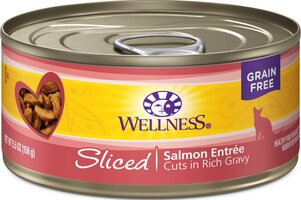
Wellness
Sliced
Salmon Entree
Wellness
Sliced Salmon Entree
First Five Ingredients
salmonfish broth
water sufficient for processing
dried egg whites
dried ground pea
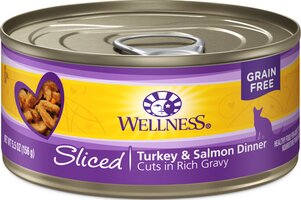
Wellness
Sliced
Turkey & Salmon Dinner
Wellness
Sliced Turkey & Salmon Dinner
First Five Ingredients
turkeyturkey broth
water sufficient for processing
salmon
dried ground pea
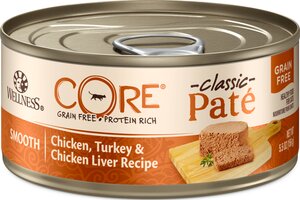
Wellness
Core Classic Pate
Chicken, Turkey & Chicken Liver Recipe
Wellness
Core Classic Pate Chicken, Turkey & Chicken Liver Recipe
First Five Ingredients
chickenturkey
chicken broth
chicken liver
chicken meal
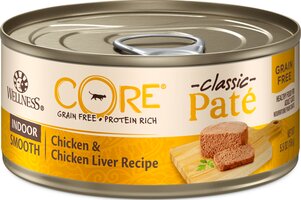
Wellness
Core Classic Pate
Chicken & Chicken Liver Recipe For Indoor Cats
Wellness
Core Classic Pate Chicken & Chicken Liver Recipe For Indoor Cats
First Five Ingredients
chickenchicken liver
chicken broth
turkey broth
chicken meal
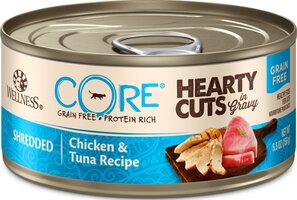
Wellness
Core Hearty Cuts In Gravy
Shredded Chicken & Tuna Recipe
Wellness
Core Hearty Cuts In Gravy Shredded Chicken & Tuna Recipe
First Five Ingredients
chickenchicken broth
fish broth
chicken liver
tuna
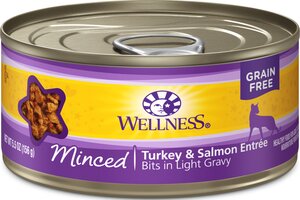
Wellness
Minced
Turkey & Salmon Entree
Wellness
Minced Turkey & Salmon Entree
First Five Ingredients
turkeyturkey broth
water sufficient for processing
salmon
dried egg whites
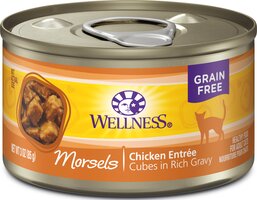
Wellness
Morsels
Chicken Entree
Wellness
Morsels Chicken Entree
First Five Ingredients
chickenchicken broth
water sufficient for processing
dried ground pea
dried egg whites

Wellness
Morsels
Tuna Entree
Wellness
Morsels Tuna Entree
First Five Ingredients
chickenfish broth
water sufficient for processing
tuna
dried egg whites
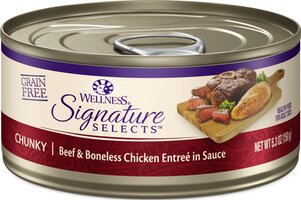
Wellness
Signature Selects
Chunky Beef & Boneless Chicken Entree In Sauce
Wellness
Signature Selects Chunky Beef & Boneless Chicken Entree In Sauce
First Five Ingredients
chicken brothwater sufficient for processing
beef
chicken
tuna
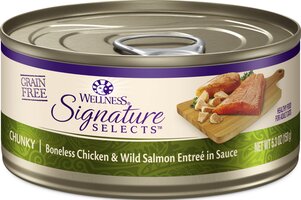
Wellness
Signature Selects
Chunky Boneless Chicken & Wild Salmon Entree In Sauce
Wellness
Signature Selects Chunky Boneless Chicken & Wild Salmon Entree In Sauce
First Five Ingredients
chickenchicken broth
water sufficient for processing
potato starch
egg
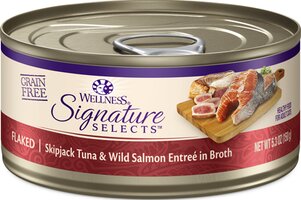
Wellness
Signature Selects
Flaked Skipjack Tuna & Wild Salmon Entree In Broth
Wellness
Signature Selects Flaked Skipjack Tuna & Wild Salmon Entree In Broth
First Five Ingredients
tunatuna broth
water sufficient for processing
mackerel
salmon
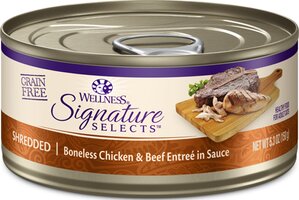
Wellness
Signature Selects
Shredded Boneless Chicken & Beef Entree In Sauce
Wellness
Signature Selects Shredded Boneless Chicken & Beef Entree In Sauce
First Five Ingredients
chickenchicken broth
water sufficient for processing
tapioca starch
potato starch
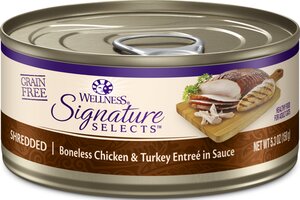
Wellness
Signature Selects
Shredded Boneless Chicken & Turkey Entree In Sauce
Wellness
Signature Selects Shredded Boneless Chicken & Turkey Entree In Sauce
First Five Ingredients
chickenchicken broth
water sufficient for processing
tapioca starch
potato starch
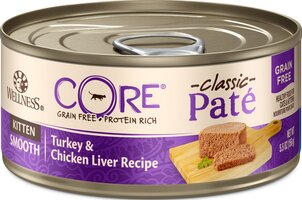
Wellness
Core Classic Pate
Turkey & Chicken Liver Recipe For Kittens
Wellness
Core Classic Pate Turkey & Chicken Liver Recipe For Kittens
First Five Ingredients
turkeychicken liver
turkey broth
chicken
chicken meal
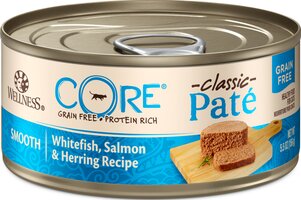
Wellness
Core Classic Pate
Whitefish, Salmon & Herring Recipe
Wellness
Core Classic Pate Whitefish, Salmon & Herring Recipe
First Five Ingredients
whitefishsalmon broth
salmon
tuna
herring
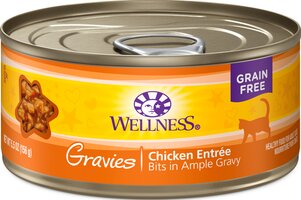
Wellness
Gravies
Chicken Entree
Wellness
Gravies Chicken Entree
First Five Ingredients
chickenchicken broth
turkey broth
chicken liver
dried egg whites
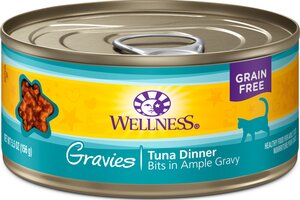
Wellness
Gravies
Tuna Dinner
Wellness
Gravies Tuna Dinner
First Five Ingredients
fish brothchicken
tuna
chicken liver
dried egg whites
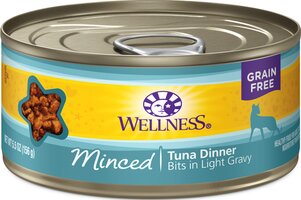
Wellness
Minced
Tuna Dinner
Wellness
Minced Tuna Dinner
First Five Ingredients
chickenfish broth
water sufficient for processing
tuna
dried egg whites
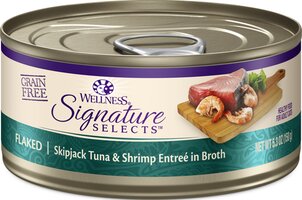
Wellness
Signature Selects
Flaked Skipjack Tuna & Shrimp Entree In Broth
Wellness
Signature Selects Flaked Skipjack Tuna & Shrimp Entree In Broth
First Five Ingredients
tunatuna broth
water sufficient for processing
mackerel
shrimp
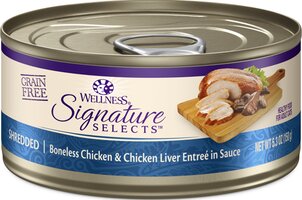
Wellness
Signature Selects
Shredded Boneless Chicken & Chicken Liver Entree In Sauce
Wellness
Signature Selects Shredded Boneless Chicken & Chicken Liver Entree In Sauce
First Five Ingredients
chickenchicken broth
water sufficient for processing
tapioca starch
potato starch
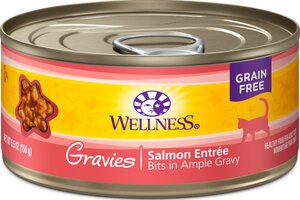
Wellness
Gravies
Salmon Entree
Wellness
Gravies Salmon Entree
First Five Ingredients
salmon brothturkey
salmon
turkey liver
dried egg whites
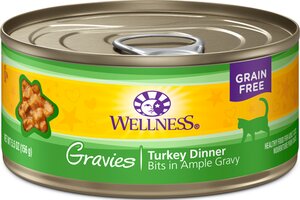
Wellness
Gravies
Turkey Dinner
Wellness
Gravies Turkey Dinner
First Five Ingredients
turkeyturkey broth
chicken broth
turkey liver
dried egg whites
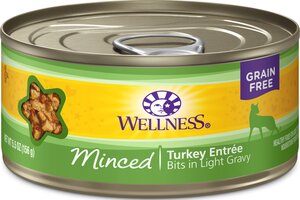
Wellness
Minced
Turkey Entree
Wellness
Minced Turkey Entree
First Five Ingredients
turkeyturkey broth
water sufficient for processing
dried ground pea
dried egg whites
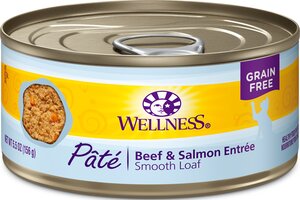
Wellness
Pate
Beef & Salmon Entree
Wellness
Pate Beef & Salmon Entree
First Five Ingredients
beefsalmon
salmon broth
beef liver
carrot
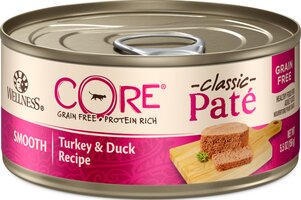
Wellness
Core Classic Pate
Turkey & Duck Recipe
Wellness
Core Classic Pate Turkey & Duck Recipe
First Five Ingredients
turkeypork liver
turkey broth
duck
cranberry
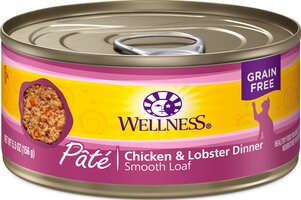
Wellness
Pate
Chicken & Lobster Dinner
Wellness
Pate Chicken & Lobster Dinner
First Five Ingredients
chickenchicken broth
chicken liver
lobster
carrot
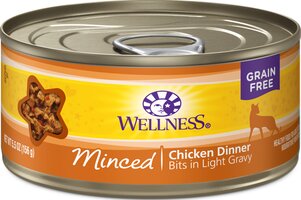
Wellness
Minced
Chicken Dinner
Wellness
Minced Chicken Dinner
First Five Ingredients
chickenchicken broth
water sufficient for processing
dried ground pea
dried egg whites
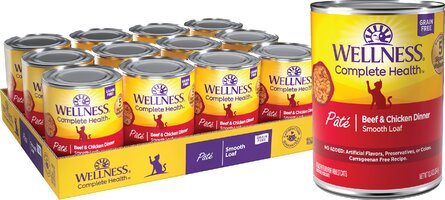
Wellness
Pate
Beef & Chicken Dinner
Wellness
Pate Beef & Chicken Dinner
First Five Ingredients
beefchicken liver
chicken
chicken broth
carrot
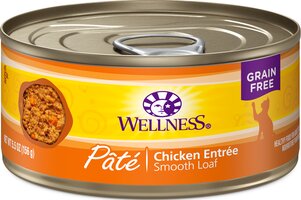
Wellness
Pate
Chicken Entree
Wellness
Pate Chicken Entree
First Five Ingredients
chickenchicken liver
turkey
chicken broth
carrot
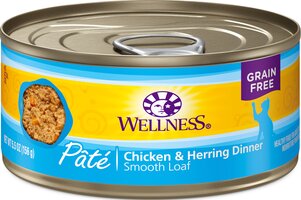
Wellness
Pate
Chicken & Herring Dinner
Wellness
Pate Chicken & Herring Dinner
First Five Ingredients
chickenchicken liver
whitefish
chicken broth
herring
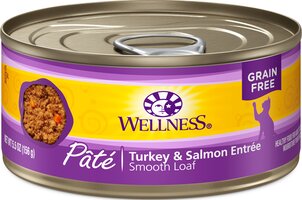
Wellness
Pate
Turkey & Salmon Entree
Wellness
Pate Turkey & Salmon Entree
First Five Ingredients
turkeychicken liver
whitefish
chicken broth
salmon
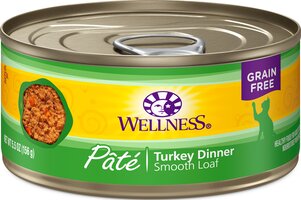
Wellness
Pate
Turkey Dinner
Wellness
Pate Turkey Dinner
First Five Ingredients
turkeychicken liver
chicken
chicken broth
carrot
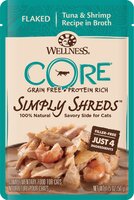
Wellness
Core Simply Shreds
Flaked Tuna & Shrimp Recipe In Broth
Wellness
Core Simply Shreds Flaked Tuna & Shrimp Recipe In Broth
First Five Ingredients
tunafish broth
water sufficient for processing
shrimp
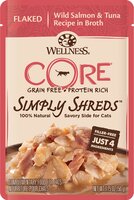
Wellness
Core Simply Shreds
Flaked Wild Salmon & Tuna Recipe In Broth
Wellness
Core Simply Shreds Flaked Wild Salmon & Tuna Recipe In Broth
First Five Ingredients
salmonfish broth
water sufficient for processing
tuna
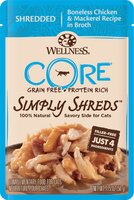
Wellness
Core Simply Shreds
Shredded Boneless Chicken & Mackerel Recipe In Broth
Wellness
Core Simply Shreds Shredded Boneless Chicken & Mackerel Recipe In Broth
First Five Ingredients
chickenchicken broth
water sufficient for processing
mackerel
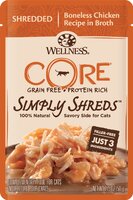
Wellness
Core Simply Shreds
Shredded Boneless Chicken Recipe In Broth
Wellness
Core Simply Shreds Shredded Boneless Chicken Recipe In Broth
First Five Ingredients
chickenchicken broth
water sufficient for processing

Wellness
Kittles
Whitefish & Cranberries Recipe
Wellness
Kittles Whitefish & Cranberries Recipe
First Five Ingredients
whitefishchickpea
pea
potato
chicken meal
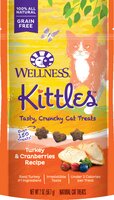
Wellness
Kittles
Turkey & Cranberries Recipe
Wellness
Kittles Turkey & Cranberries Recipe
First Five Ingredients
turkeychicken meal
chickpea
pea
potato
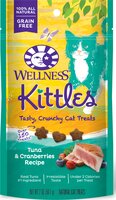
Wellness
Kittles
Tuna & Cranberries Recipe
Wellness
Kittles Tuna & Cranberries Recipe
First Five Ingredients
tunachickpea
pea
potato
chicken meal
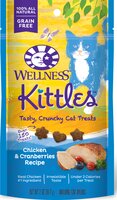
Wellness
Kittles
Chicken & Cranberries Recipe
Wellness
Kittles Chicken & Cranberries Recipe
First Five Ingredients
chickenchicken meal
potato
chickpea
pea
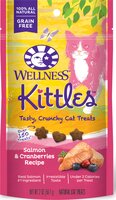
Wellness
Kittles
Salmon & Cranberries Recipe
Wellness
Kittles Salmon & Cranberries Recipe
First Five Ingredients
salmonpea
potato
chickpea
chicken meal
